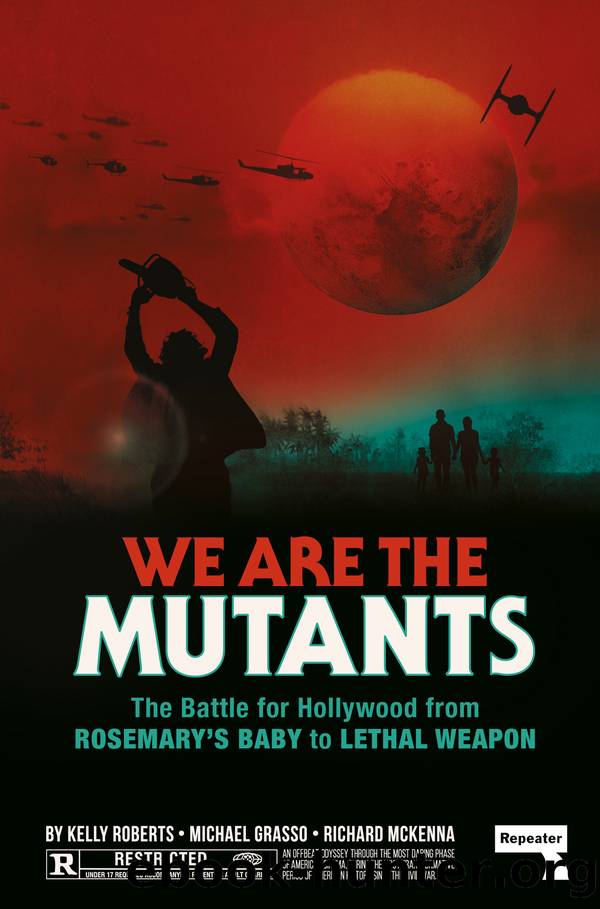We Are the Mutants by Kelly Roberts

Author:Kelly Roberts
Language: eng
Format: epub
ISBN: 9781914420740
Publisher: Watkins Media
Published: 2022-10-14T16:00:00+00:00
The camera pulls further and further back, revealing that the window Lowell is looking out of is in fact set in the hull of a vast spacecraft, its flank decorated with the United States flag and the American Airlines logo.
This scene introduces the future Silent Running inhabitsâa future where, for its protection, the scant remaining plant and non-human animal life on Earth has been gathered up and packed off into interplanetary space aboard a fleet of space freighters, each named after a United States national park. Itâs an absurd conceit that immediately tells us the film is far closer to being a tonal poem than anything resembling scientific possibility. In fact, practically nothing in Silent Running makes any sense at all on a rational level, the filmâs undeniable power generated almost entirely by the surreal aesthetic world itâs set in, which plays out like a fever dream of techno-fetishism and cosmic ecology colliding.
Lowell and the three other men weâve met crew the Valley Forge, a descendant of the real-life Essex-class aircraft carrier of the same name (decommissioned during the Vietnam War) in which most of the filmâs interiors were shot as a way to cut costs. The spaceshipâs exterior is clearly inspired by the Expo Tower at the 1970 Osaka Expo, the work of Japanese architect Kiyonori Kikutake, one of the founders of the postwar architectural movement called Metabolism, which aimed to fuse ideas about architectural megastructures with ideas about organic biological growth. Resembling âhorizontal Eiffel Towers attached to gigantic oil tankers,â as Vincent Canby described them in his review in the New York Times,1 this folding of battle-scarred and mothballed military-industrial-complex power inside a superstructure of nominally progressive architecture feels peculiarly apt. The reveal of the ship is an astonishing moment, and introduces the audience to the structures housing the forests: vast transparent domes attached to the terminus of the Valley Forgeâs superstructure.
A potent symbol of both domesticity and institutional power across many cultures, domes had sprung up across North America in the preceding decade like the sleek caps of psychotropic mushrooms. Before that, architects like Wallace Neff proposed domed âbubble homesâ in the 1940s,2 and one of the first completed works of Italian-born architect Paolo Soleri, creator of the proto-hippy concept of âarcologyâ (described as âthe fusion of architecture with ecologyâ),3 was the 1948 dome house he built in the Arizona desert. In the late 1950s, ufologist George Van Tassel built his domed âIntegratronâ near Joshua Tree in California, which he claimed could cause cellular rejuvenation and allow research into anti-gravity and time travel.4 The geodesic dome, however, popularized by the unlikely countercultural guru and self-promoting quasi-grifter R. Buckminster Fuller in his 1969 book, Operating Manual for Spaceship Earth, was of a different domain: a restless generation began to see in the shape a symbol of a new kind of future.
Fullerâs signature design was built using a three-dimensional framework of regularly repeating forms made out of strong, lightweight construction materials that were cheap and ideal for rapid assembly.
Download
This site does not store any files on its server. We only index and link to content provided by other sites. Please contact the content providers to delete copyright contents if any and email us, we'll remove relevant links or contents immediately.
Kathy Andrews Collection by Kathy Andrews(11739)
The remains of the day by Kazuo Ishiguro(8833)
Paper Towns by Green John(5094)
Spare by Prince Harry The Duke of Sussex(5078)
Industrial Automation from Scratch: A hands-on guide to using sensors, actuators, PLCs, HMIs, and SCADA to automate industrial processes by Olushola Akande(5001)
The Body: A Guide for Occupants by Bill Bryson(4978)
Machine Learning at Scale with H2O by Gregory Keys | David Whiting(4200)
Be in a Treehouse by Pete Nelson(3956)
Never by Ken Follett(3801)
Harry Potter and the Goblet Of Fire by J.K. Rowling(3776)
Goodbye Paradise(3730)
Into Thin Air by Jon Krakauer(3316)
The Remains of the Day by Kazuo Ishiguro(3296)
The Cellar by Natasha Preston(3265)
Fairy Tale by Stephen King(3231)
The Genius of Japanese Carpentry by Azby Brown(3228)
120 Days of Sodom by Marquis de Sade(3185)
Drawing Shortcuts: Developing Quick Drawing Skills Using Today's Technology by Leggitt Jim(3002)
The Man Who Died Twice by Richard Osman(2998)
